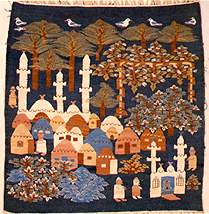|
FINE COTTON WEAVING
 Harrania - 1990
Harrania - 1990 |
In order to diversify and widen the scope of weaving, in
1962 Ramses introduced cotton weaving into the workshop. For
this method the cotton threads used are very fine and the
vegetable-dying method very slow and complicated. In spite
of its novelty at the center, the children did not take to
the new technique easily and the experiment lapsed. Only two
of the original cotton weavers continued working while the
remainder returned to wool weaving.
It was not until after Ramses Wissa Wassef's
|

|
death that his daughter Yoanna decided to expand this method.
Continuing with what her father had earlier started, Yoanna
describes her role with the second generation cotton weavers.
"When I went to work at Harrania after
my father's death, I decided to revive the cotton weaving
with a group of 15 children who had no parental links with
the previous ones. They were happy to take part in the school
and accepted more readily the difficulties of the technique.
They even felt a certain pride as they were no longer considered
an appendage to the wool weavers, but rather a new group with
its own identity. What is also remarkable to note is that
I often found in their tapestries details reminiscent of the
ancient Coptic fabrics, which of course, they had never seen."
The difference in the two types of weaving becomes clearer
here. The technique of cotton weaving calls for different
and perhaps more difficult skills than high warp, wool weaving.
in cotton weaving the looms are horizontal opposed to vertical
and the threads are very fine.
As a result, the image takes longer to appear. In fact all
phases of the work take greater patience and perseverance.
Even the dyeing process is more demanding since cotton does
not take natural dyes easily. The reward, however, lies in
the result. This method produces weavings of great intricacy
and clarity. The fact that a ten year old boy soon mastered
the technique providesfurther evidence of Ramses Wissa Wassef's
original theory concerning our natural gifts of creativity.
|
|